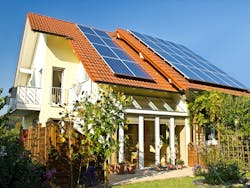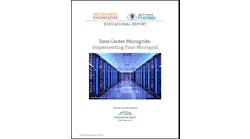California has opened the door for residential microgrids in all new homes with the recent release of 2019 building standards aimed at improving energy efficiency.
By anweber/Shutterstock
Issued by the California Energy Commission, the 2019 Building Energy Efficiency Standards require solar photovoltaics for all new homes. They also provide new home builders with incentive to include energy storage and to focus on demand response opportunities — all common elements of residential microgrids.
“These new codes are a good step toward making sure every house can be its own microgrid,” said Kelly Speakes-Backman, CEO of the Energy Storage Association.
Homes with onsite generation, storage, smart inverters and controls will have what they need to ride through outages.
“This is a big deal for storage,” she said. “Storage is already on a path of growth in California.”
Just as important, the new building requirements don’t just focus on batteries. Homeowners can also use water heaters, for example, as a form of storage for demand response programs, she said.
The new code requirements provide credits toward a building energy scoring system, including credits for thermal storage, Speakes-Backman said.
The credits, or energy incentives, are calculated when the features of the home are entered into energy modeling software during home construction, according to Amber Beck, spokeswoman for the California Energy Commission.
An exception in the solar requirements say that the PV capacity for a home can be reduced by 25 percent if installed with battery storage.
Additional energy incentives aim to encourage battery storage and heat pump water heaters that shift the energy use of the house from peak periods to off-peak periods. The standards also mandate technologies that help with demand response — thermostats in homes or lighting controls in nonresidential buildings, for example.
Incorporating demand flexibility
Incorporating demand flexibility becomes an important emphasis during the design of new buildings, said Speakes-Backman.
“Half the energy demand is heating and cooling. Thermal storage playing into demand response will be an important part of the whole California grid,” she said.
The new code also provides compliance credits for using energy storage technologies, when, for example, there are few options for the required energy efficiency or solar in a home.
Overall, the new standards represent a shift toward electrification, demand response, and storage, said Bronwyn Barry, an architect who is president of North American Passive House Network.
More nuanced accounting of carbon
“It’s a more nuanced accounting of the impact of energy on carbon emissions,” she said. For example, net metering at times incentivizes excess generation to be pumped into the grid. With battery storage, that extra generation can be stored and used at night.
As explained by the CEC in its FAQ about the new code: “It is critical that rooftop solar generation does not substantially exceed the home’s electricity use. It is ideal to generate the electricity and have it used on-site versus exporting it to the grid at a time it may not be needed.”
“It is critical that rooftop solar generation does not substantially exceed the home’s electricity use” — CEC
When all the rooftop solar is used to offset on-site electricity consumption, the home has virtually no impact on the grid, which cuts the home’s greenhouse-gas emissions, the CEC said.
Looking forward, it’s most important for buildings to produce and consume energy at times that are appropriate and respond to the need of the grid, said the CEC. This reduces the building’s emissions.
Effective in 2020, the new building standards aim to cut energy use in new homes by more than 50 percent, the equivalent of taking 115,000 fossil fuel cars off the road. The CEC calculates that on average the standards will increase the cost of new home construction by about $9,500, but will save $19,000 in energy and maintenance costs over 30 years. That translates into about $40/month more on an average mortgage payment, but a reduction of $80 monthly on energy bills.
Read more about residential microgrids here on Microgrid Knowledge.









